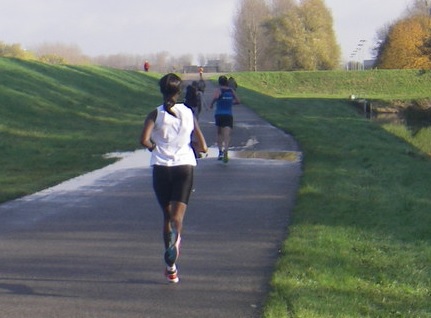“Why do they always look at me like that?”
That’s what I think when I consistently see the same white men and women on the running trail in my neighborhood. My boyfriend and I recently moved to this neighborhood, motivated in part by the vast amount of running trails in the area. Granted, I see more people using the trails to walk their dogs in the morning, but I don’t mind the dogs. What I do mind are the constantly surveilling eyes that watch me as I jog over the bridge. I cannot help but think that their gaze is a response to both my being black and running on the trail. My blackness may be disrupting their racially homogenous space, and my activity may seem odd…or suspicious.

Peter van der Sluijs [GFDL or CC BY-SA 3.0], from Wikimedia Commons
I run down the hill and see a black woman about my age, jogging with her phone in one hand and water bottle in another. The items seem to constrain her range of motion and prohibit her from achieving proper running form—she appears to be struggling. Subconsciously, I turn up the volume on my iPod and start to keep pace with the rhythm of my favorite workout song. My feet begin to mimic the bass. Boom, boom, clap. Boom, boom, clap. I competitively quicken my pace and secure ideal running form as I run past the black woman. I make sure that my chest is high and elbows are in—I even begin to sing the lyrics. Ironically, the lyrics are “lemme show you how it’s done,” which I sing loudly and proudly as I breeze past the other black woman. I sense her gaze, but unlike the white couple, it does not anger me. Her gaze makes me want to work harder. Her gaze makes me unclench my fist and snap to the beat of my music instead. And most importantly, it makes me run faster and not think about any muscular pain that I begin to acquire in response to my quickening pace.
“Okay T, hustle up,” I tell myself as I approach the last hill of the 3.1 mile trail. Seeing nobody, and I began to ease up and regain control of my breathing. My lungs fail to keep up with the fluctuation of emotions that accompany me on this morning’s run. I even feel a little light-headed, but I knew I could not stop until I made it up that last hill. A slower song comes on, and again, my feet mimic the bass to the new song, which involves seeing the police behind you and still refusing to stop. I feel obligated to keep my pace even though my lower back begins to throb. The last hill is always the worst. Despite the sweat was dripping onto my eyes and my form breaking down, I could not stop. I was watching me.
“I ain’t gonna stop” were the lyrics that played as I successfully finished my morning run.
***
It is not uncommon to read embodied narratives about athletic failure and triumph. Sporting narratives often promote a ‘healthist’ narrative, focusing on individual responsibility and success, and often aligning with the dominant ideology that a sporting body is also a disciplined and civil body. However, the language used in this embodied narrative does not demonstrate disciplined and civil connotations, nor does the language promote the same ‘values’ as other autobiographical narratives that are focused on physical activity. This may be due to the racial underpinnings of the narrative.
The purpose of this embodied narrative is to disrupt the dominant belief that black women do not exercise, or in this case, run. This belief may stem from the continuously promoted statistic: 60% of black women are obese. This statistic is an essential generator of obesity discourse, which often situates black women as being unable to engage in physical activity due to lack of time, resources, and motivation. This narrative gives a different “meaning to being black, female, and physically active as it situates the black female body in an ‘abnormal’ space. Leach (2012) states, “what we really think about bodies that differ from the norm is important because our beliefs about normal embodiment become normative”. What is considered a ‘normal’ practice becomes embodied within society, and bodies that do not succumb to what is ‘normal’ are considered anomalies. However, both normal and abnormal bodies, generate social meanings, and impact the individual’s identity, therefore warranting a need for more investigations into the embodied consciousness of the physically active black female as black female obesity rates continue to rise.